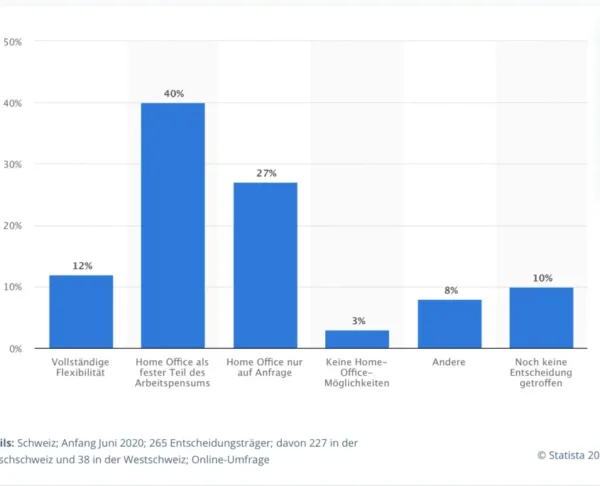Is Work from Anywhere about to be the rule?
Many people nowadays are more or less forced to work from home. In April and May 2020, there were even more. While everyone wishes for the speedy return of freedom and the carefree everyday life, the home office has revealed significant advantages. CO2 emissions decreased by 17 percent between April and May; not even climate activists would have dreamed of such an effect. Consumers have saved quite a bit by giving up their usual leisure activities and expensive holidays abroad. We hear that women are using fewer cosmetics, and many are getting used to making big breakfasts at home. Even pets benefit from the permanent presence of their owners. Given the advantages of the home office, one might think that the working world would move toward a general spread of the idea of the home office after the pandemic. But is this the case?
How executives look at the idea of Home Office
A central question to managers is that of productivity. Many of them tend to believe that employees who work from home are less productive. This mistrust of people working from home is even shared by employees on the company premises. But in 2015, an American research revealed that working from home increases the productivity of those affected by an average of 13 percent [1] In a survey of Swiss employees that was carried out in June 2020, 47 percent of the respondents agreed with the statement that they tend to work too much from their home offices. For 28 percent of the surveyed employees, working from their home offices made communication more difficult [2]. Managers’ suspicions that their employees generally lay their hands in their laps at home is far from well-founded. The home office has not been part of employer branding until today. American companies such as GitLab have been operating without offices and have let their sales, engineering, marketing and HR teams work remotely from 60 different countries. Countries like Estonia and Barbados have even introduced a new type of visa for such employees[3]. Tata Consulting Services (TCS) uses the SBWs concept, which stands for Secure Borderless Workspaces. It is important to engage candidates with the right skills in all projects, regardless of where they live. Accordingly, the TCS CEO speaks of ‘talents on the cloud.’[4]
Some advantages of home office or WFA
Workforce independence brings significant benefits to employers. You can choose your talents from a limitless reservoir. Job seekers might suffer from this increased competition, but they also benefit from flexibility in their workplace. Choosing a place of residence according to your budget or just following the sun is tempting. You can definitely live on the Italian Riviera and work for an organization based in Sweden or change your place of residence again and again, depending on your mood. Actually, one speaks not only of a home office but of WFA, that is, work from anywhere. The era of the so-called ‘digital nomads’ has begun and is particularly fascinating for millennials.
Home office also has its downside
However, working from home doesn’t just bring advantages; remote work also brings with it a new level of complexity, primarily in communication. In every team, constructive interaction is crucial for success. The shortcomings in communication in distributed teams have numerous effects. For example, team members no longer just stand up, pat their colleague on the shoulder and ask a question. Thus, the daily exchange of knowledge is inhibited. Communication not only supports daily, professional discussions but is essential for social exchange. Many people criticize the fact that distance negatively affects interpersonal relationships. The sense of belonging is disappearing. However, the effects of conflict are even worse. Due to the lack of transparency, a bullying case has irreparable consequences. Working in a virtual environment does little to promote friendships; rather, it creates feelings of loneliness. Therefore, it is understandable that some managers have reservations about working from home. It’s not about the employees’ productivity per se. Rather, there is a lack of physical closeness, especially during sensitive conversations. The periodic performance assessment is the subject of such discussions. If the employees are permanently remote, as in internationally distributed teams, the question arises whether an objective assessment is even possible.
People analytics as a solution
At this point, HR and line managers can use digital solutions: so-called people analytics. The concept of people analytics consists of analyzing personal data that results from various surveying practices using big data and artificial intelligence methods like machine learning. ‘Technological progress and the scaling of “traditional” surveillance technologies that have already taken place open up promising opportunities for companies.’ [5], data is collected to support the employee selection, workplace design, compliance and performance management and employee loyalty and development. This method is based on analyzing emails and phone calls as well as all email traffic. Additionally, mood and screen analyses are carried out, and data generated by electronic ID cards and access control systems is also used. However, these procedures can strongly evoke a ‘Big Brother is watching you’ mentality within the workforce. This raises a central question that HR managers and managers should consider, while taking ethical aspects and the data protection act into account: How do people analytics processes affect employees’ trust and the corporate culture?
Post-pandemic forecasts for home office
The question asked at the beginning, regarding whether employers will increasingly be allowed to work from home offices after the pandemic, cannot be answered on a general level. It has to be answered by each organization after taking into account its specific operational conditions and cultural circumstances. Nevertheless, some surveys that were carried out in 2020 involving employees and employers provide some clues about the future. Results show that 79 percent of the employees who were surveyed can imagine working at least partially from home after the pandemic. While 27 percent of employers will only allow home offices on request, 40 percent of those surveyed plan to introduce the home office as a fixed part of their workload. Finally, 12 percent of those surveyed intend to allow full flexibility between the home office and on-site work [6]. Thus, a wider use of the home office can be expected after the pandemic.
Conclusion
Driven by technological progress, home offices will establish themselves more often as alternative or complementary workplaces in the future. Individuals and teams who want to fully benefit from the advantages home offices offer should adapt their working methods accordingly. A balanced combination of home office and an on-site workplace counteracts potential feelings of loneliness. Communication on your part should not only be optimally supported by technology but above all should be lived with increased awareness on the part of everyone involved in everyday life. The quality of leadership, communication, and cooperation has an enormous influence on the performance of individuals and teams. That is why—particularly in these difficult times—it is appropriate for managers to approach the development of their teams actively and situationally. In this sense, adaptability and agility are more in demand than ever.
Quellenangaben
[1] P. Choudhury (2020). Our Work-from-Anywhere Future. In Harvard Business Review, S. 58-67. [2] Source: Statista [3] dito [4] dito [5] Weibel, A., Schafheitle, S. & Ebert, I. (2019). Goldgräberstimmung im Personalmanagement?. In Organisations-entwicklung Nr. 3, S. 23-29 [6] Source: Statista






